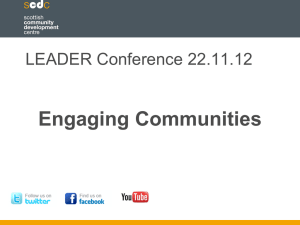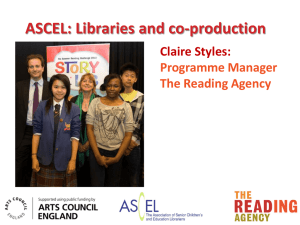Co-design and co-production are concepts that
advertisement
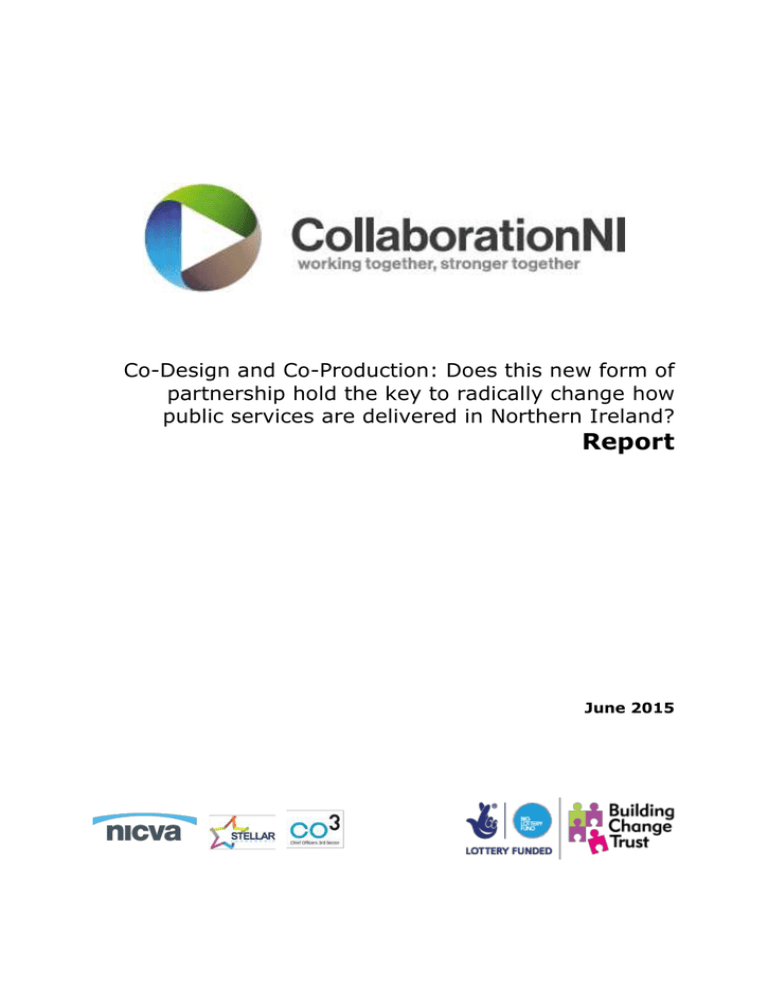
Co-Design and Co-Production: Does this new form of partnership hold the key to radically change how public services are delivered in Northern Ireland? Report June 2015 Table of Contents List of abbreviations ................................................................................................................................ 1 Introduction to CollaborationNI ............................................................................................................. 2 Co-Design and Co-Production: Does this new form of partnership hold the key to radically change how public services are delivered in N. Ireland? .................................................................................... 3 Co-design & Co-production lessons learnt from the Welsh approach ................................................... 4 Joining the Co-design & Co-production Dots in Northern Ireland – Community Development and Health Network ....................................................................................................................................... 7 Joining the Co-design & Co-production Dots in Northern Ireland – Carnegie Trust ............................ 10 Joining the Co-design & Co-production Dots in Northern Ireland – Volunteer Now ........................... 13 Reflections and Next Steps ................................................................................................................... 16 Feedback and Key Messages................................................................................................................. 19 List of abbreviations CO3 CDHN CNI CPD DEL DFP GDP NICS OECD RPA VCSE Chief Officers 3rd Sector Community Development and Health Network CollaborationNI Central Procurement Directorate Department of Employment and Learning Department of Finance and Personnel Gross Domestic Product Northern Ireland Civil Service Organisation for Economic Co-operation and Development The Review of Public Administration Voluntary, Community and Social Enterprise 1 Introduction to CollaborationNI CollaborationNI (CNI) was formally launched on 30 March 2011, as a consortium between NICVA, CO3 and Stellar Leadership, commissioned by Building Change Trust. CNI provides practical support and resources across the whole spectrum of collaborative working to voluntary and community sector organisations. As part of Phase One of CNI, 553 events were held covering training, expert facilitation, legal support sessions, coaching and policy seminars for over 4,000 individuals from 754 organisations. Phase Two, launched in September 2014, aims to produce deeper collaborations which will influence policy and decision makers. It will see an extension of the debate through a range of policy symposiums which will continue to challenge our thinking, examine current approaches and focus on particular models of collaboration, under a number of thematic areas, including health, social housing, young people, arts, criminal justice and older people. The aim of the policy symposiums is to challenge, inform and develop political and government thinking about the support requirements of the Voluntary, Community and Social Enterprise (VCSE) sector to encourage and cultivate a culture of effective collaboration. The broad range of discussion will also provide an opportunity for VCSE sector leaders and government officials to learn from good, and not so good, practices in Northern Ireland and elsewhere in building effective collaborations, resulting in improved services and better client outcomes. The role of CNI is to facilitate discussions on the theme of collaboration in a way that that delivers better outcomes through high quality, professional services. CNI aims to help the VCSE sector to work better together and has provided a range of different services to over 900 organizations. The support provided by CNI can be categorized into four broad areas: Action planning support; Legal advice; Expert facilitation; and Events. For further information on the work of CollaborationNI please visit collaborationni.nicva.org 2 Co-Design and Co-Production: Does this new form of partnership hold the key to radically change how public services are delivered in Northern Ireland? Co-design and co-production are concepts that are growing in profile and have enormous potential and momentum for collaboration between the public and Voluntary, Community and Social Enterprise (VCSE) sectors. In order to be fully embraced they will require an approach that shifts beyond engagement and places citizens at the centre of the design and delivery of key services. This will create, foster and leverage collective ownership, whilst at the same time allowing us to achieve more by working together. We are all aware that public services are struggling to cope with increased pressure and decreased levels of funding and in that context there is a recognition that we need to find new and innovative ways of delivering services. The policy symposium jointly facilitated by CollaborationNI and Volunteer Now; provided an opportunity to learn from models of good practice in England and Wales and to piece together the projects and work that has been undertaken within Northern Ireland. The symposium heard from a number of different speakers, who had experience in the co-design and co-production process and were given an opportunity to tell their story and share their experiences. The speakers were: Becky Booth, Chief Executive Officer, Spice; Kathy Martin, Pathways to Health Project Manager, Community Development and Health Network); Dr. Peter Doran and John Woods, Carnegie Trust, Health and Wellbeing Framework; Wendy Osborne, Chief Executive Officer, Volunteer Now; and Dr. Colin Sullivan, Director of Strategic Policy and Reform, Department of Finance and Personnel. Following the presentations there was a Question Time style discussion were speakers were able to expand on their presentations and engage in a wide ranging discussion session with questions from delegates being debated. 3 Co-design & Co-production: Lessons Learnt from the Welsh Approach Spice began as a University of Wales Institute, working mainly in the Welsh Valleys, and has since grown into a social enterprise working across the UK. Spice's agency time credit applications encourage people to engage more in the design and delivery of public and community services and support people to take more active roles in their communities. Spice originated out of a study into the experience of service delivery in former mining towns in south Wales. These former mining towns had a culture which valued ‘community’ and ‘give and take,’ which manifested itself in the community’s decision to collectively finance and build a community hall, from which services were delivered. The services delivered in the hall were provided for the benefit of the local community and there was an expectation that those who received those services would also provide services for other members of their community. For Spice, this posed the challenge of how to create modern day public services that incorporated a culture of reciprocity and valued working with, not for, the community. What emerged from this was a conversation about designing a new currency, which had a different set of values from the national currency, and could bring about change. The aim was to develop a currency that was a modern day tool for creating opportunity. At this time the notion of ‘coproduction’ was not used but it became apparent that this is what they were doing. Becky Booth Chief Operating Officer, SPICE Becky is Chief Executive and co-founder of Spice; a social enterprise that develops agency time banking systems for communities and public services. Becky has extensive community development experience and was involved in developing the principles of the now successful time credit systems. Co-production is a way of thinking about public services that believes that it is better for professionals to design services with communities, rather than for them, turning members of the community from passive recipients into active partners, with professionals supporting change, not delivering it. A good example of co-produced services is the classic neighbourhood watch- a service design by the community, run by the community and answering needs defined by the community, supported by the professionals. This is a practical, common sense example of co-production, but co-produced services are also based on the principle that services should be co-owned by the state and citizens, and that everybody has something of value to offer. What people might have to contribute may have no monetary value- it could be kindness or the ability to care for someone. Co-production assigns value to these 4 fundamental human gifts; that are not valued in the monied economy, but are essential for all of us to co-exist. With the current strain on public services, co-production is now more important than ever and is the best way to make these services more economical in the long run and better quality for the people they serve. Since service users help to design their own services, they are more effective and relevant. They are also more sustainable since engaging communities to design their own services encourages buy-in and ownership. Co-produced services also have the knock on effect of having active participation from service users. The impact can be massive, as it was in Falmouth, Cornwall, when co-produced community programmes contributed to a reduction in unemployment of 71% and in post-natal depression by 70%. In Glencore, South Wales, a co-produced strategy for community safety reduced crime rates from the highest in the area to the lowest. In Ely, in Cardiff, time credits have had such an energising effect that 600 people contributed 12,000 hours in one year. When faced with a new challenge, the first question considered in co-production is not what do people need but what can everybody give and how can we plug this gap together? To consider this, Spice set about creating a tool that would help local councils, housing associations and schools to think about and implement co-production. The challenge was turning the principles of co-production into reality, in a way which enabled the community to get involved, from which emerged the idea of Time Credits. Time Credits are a simple concept: for every hour contributed by a citizen to designing and delivering services they earn one time credits. Credits can then be used to access events, learning, cultural or leisure opportunities, or to trade time with neighbours. This, again, works on an hour-for-hour basis, so a community event lasting for two hours will require two time credits to access. Time Credit systems are hosted by community groups, local governments, schools, housing associations, prisons and development trusts. In this system, a tenant who gives his time by helping to run a local out-ofschool club can then spend that time on, to use one example of many, attending a concert at a venue owned by a Spice network Time Spend partner. Time Credits are proven to increase the number of people involved in the community and are able to help sustain that involvement over time, bringing about a range of transformative outcomes. The real, social impact of time credits is actually the greatest in the spending, not the earning, of the credits. The increased level of social contacts, the feelings of self5 worth, have a massive impact on individuals, and the wider community. People end up spending their Time Credits doing things they would not otherwise have done, such as going to the theatre, which is brought about as people have a changed perspective about themselves and what they can actually do. If people feel better about themselves, and can see the impact that their volunteering has and the benefits they can bring to society, they too feel the benefit of bringing about change. 6 Joining the Co-Design & Co-Production Dots in Northern Ireland – Community Development and Health Network Based in Newry, Community Development and Health Network’s vision is to work towards ending health inequalities using a community development approach. Their mission is: to be the leading organisation championing community development approaches to tackling health inequalities; to be a centre of expertise that develops best practice, advances knowledge and develops tools for action; and to ensure that communities can define and represent their own health needs and design and implement radical solutions. Kathy Martin Pathways to Health Project Manager, CDHN Community Development and Health Network (CDHN) see co-production and co-design as really important ways of joining together the strands of their work and offering an opportunity to engage with other agencies and sectors beyond their traditional partnership arrangement. Whilst the terminology of coproduction and co-design may be relatively new, they are not an entirely new way of working as their principles are long established in working practices and approaches. The Building Community Pharmacy Partnership has seen CDHN distribute funding to community groups and pharmacists for the past 17 years, to engage in developing and designing services in their area, based on a co-production model. These partnerships have really engaged with local people and by treating partners as equals has had a transformative impact within the community. 7 Co-production and co-design allows the development of a shared language around an agreed approach and to develop a shared understanding of that language and to focus on the process, at a time when most attention is centred out outcomes. Some of the strands of the work of CDHN, where co-production and co-design are particularly important, are highlighted in the diagram on the right. Key to this is that the people who use the services have to be involved in the design and delivery of those services. CDHNs work is about making a difference and highlighting the difference between people centred services and services that are individually focused around behavioural changes and lifestyle choices, in order to help create healthy and resilient communities. At a policy level in Northern Ireland it would be difficult to find a strategy or policy document that does not claim to have engagement at its core, but on a practical level such engagement is often superficial. Co-production can be a good way of turning that policy intention into practice. CDHN are currently involved in a piece of work with the new Antrim and Newtownabbey council, where there are facilitating a process of coproduction. This came about through a desire from the Council to have a deeper and more meaningful engagement with its citizens, as a direct result of evidence from a programme that had been run with Action Mental Health and New Horizons, called the Muddy Minds project. This was a gardening project that allowed the Council to see firsthand the benefits that gardening activities could provide for people with mental health problems. One of the reasons that this project was a success was that the participants actually felt that they were part of something: they designed and planned the services whilst at the same time digging and planting the garden. The Council were able to see the impact that this project had on health and wellbeing which in turn encouraged them to adopt a similar approach to future service and strategy design. CDHN suggested that co-production shouldn’t be too radical a concept for people in Northern Ireland as there are numerous examples of it in action and being successful. Whilst co-production is not an overly ambitious concept, with many suggesting that it is merely common sense, for some it has been perceived as being too radical. In a context within which change is necessary to how we design and deliver services, the knowledge and the skills to make co-production a success already 8 exist. For it to be successful it requires leadership and a commitment to identify assets and release capacity. There is a need to be realistic about what co-production can deliver because it is both time and resource intensive. Significantly, it requires change in the power dynamic, because for coproduction to be a success, service users have to be empowered and given a role in the design and delivery of services. For further information please join the Co-Production NI Facebook page. 9 Joining the Co-design & Co-production Dots in Northern Ireland – Carnegie Trust The Carnegie UK Trust works to improve the lives of people throughout the UK and Ireland, by changing minds through influencing policy, and by changing lives through innovative practice and partnership work. John Woods Dr. Peter Dornan John Woods and Peter Dornan’s research came out of the notion that Gross Domestic Product (GDP) is an inadequate measure of social progress, as increases in recent decades have not resulted in increased quality of life and wellbeing. As a result of this, their research has focused on other ways of measuring quality of life and wellbeing. Eighteen months ago, they organised a conference in Belfast which resulted in the publication of the Measuring Wellbeing in Northern Ireland report. Speaking at the conference was the then Finance and Personnel Minister, Simon Hamilton MLA, and the Chair of the Assembly’s Finance and Personnel Committee, Daithi McKay MLA, which created a dynamic and stimulated interest in these issues. In a joint foreword to the report the two MLAs said: “It is time to place the wellbeing of our citizens at the heart of what government is about, at the heart of a shared narrative.” The outcome of the conference was the establishment of a roundtable which would explore these issues over the next year. The roundtable comprised of senior civil servants, local government, VCSE sector leaders, academics, business representatives and two politicians, which made for an interesting and creative mix of people working together. The roundtable met four times, had a study visit to Scotland, carried out focus groups with citizens and held a series of stakeholder interviews, producing some really interesting results. Their report was presented to Minister Hamilton in March 2015, and speaking at that launch the he said: “This [report] sits well with the ethos of public sector reform – putting the citizen at the centre of service delivery… The proposals for a wellbeing framework for Northern Ireland are timely. I intend to discuss this report 10 with Executive colleagues and explore how we might progress the development of a wellbeing framework for Northern Ireland.” The report was launched and set out Seven Steps to put wellbeing at the heart of government in Northern Ireland, setting it as a collective goal for all Executive departments, and creating a wellbeing framework. This is a long term framework which would guide future Programmes for Government (PfG), creating a consensual approach to the outcomes that they want to achieve for society over time. This is a recognition that there are a The Seven Steps - Putting Wellbeing At The Heart of Government large number of issues that cannot be sorted out in a single Assembly mandate but require a long term, joined up approach to governing. Six Strategic Commitments 11 The collective purpose of the wellbeing framework is to improve the wellbeing of everyone, by cultivating a peaceful, prosperous and fair society, now and for future generations. In order to achieve, politicians are required to develop strategic commitments on areas such as deepening democratic engagement, building a more inclusive society and living long and healthy lives. Coming out of these strategic commitments would flow a number of outcomes, which would create measurable objectives to deliver enhanced wellbeing. The creation of the roundtable has allowed the conversation to constantly shift between the global conversations that are occurring and then to think about the very particular and unique within which we are processing these ideas. When we engage in a policy discussion we sometimes get carried away in strategic considerations and forget to go back to the origin. It is always vital to bring the richness of our human need into production to addressing the blindspots that are created about the conventional notion of the ‘public’ and the ‘private’. Co-production can facilitate a focus on wellbeing, attempting to find new ways of working, designing and imagining public policy. One example of this is the shift from the linear to the circular economy, where you do not try to ‘solve’ a problem, but you reimagine it and try to work out how to redesign the waste out of the system. Another place in which co-production meets wellbeing is in the Capability Approach, which helps us to create an understanding that participation and the quality of our engagement are fundamental needs for society. Communities need to cultivate a particular approach so that wellbeing and democracy are both the rationale and the outcome. Democracy should not just be used to generate policy outcomes, but a flourishing democracy should address some of our fundamental human needs, going well beyond the need for commodities. There is also a need for us to develop an Enabling State, reimagining how the State sees itself, including those who are traditionally tasked with designing policy and ‘handing things down’. This would require a shift to a vision where those working in the public sector recognised that they neither have, nor ought to be expected to generate, all the answers. Instead, those public servants would be required to engage with local communities, as well as the VCSE sector, to encourage the development of new approaches to social problems. 12 Joining the Co-Design & Co-Production Dots in Northern Ireland – Volunteer Now Volunteer Now is the lead organisation which works to promote, develop Wendy Osbourne and support volunteering across Northern Ireland. Their work enhances Chief Executive Officer, recognition for the contribution volunteers make, provides access to Volunteer Now opportunities, encourages people to volunteer and provides information and support to volunteer involving organisations on volunteer management and safeguarding vulnerable groups. “Co-production means delivering public services in an equal and reciprocal relationship between professionals, people using services, their families and their neighbours. Where activities are co-produced in this way, both services and neighbourhoods become far more effective agents of change.” -New Economics Forum Co-design and co-production fit very neatly into the work of Volunteer Now, which is about the promotion and development of volunteering. At the very heart of this is mutual aid and self-help, which are fundamental to the whole concept of volunteering. Volunteering involves people giving time freely and without monetary gain, to be active in their communities, taking them out of their 13 own family environment, that does something which is beneficial to another individual or the community at large. Volunteer Now’s motto is ‘Connect. Build. Change’; which means that volunteers connect with each other in their community and build relationships that effect positive change for them and for their communities. This goes to the very heart of what co-production is about, and recognises the importance of volunteering to society and to the individual volunteer. In 2008/09, Volunteer Now looked at timebanking as a new way for citizens to become active volunteers, based on the idea that every citizen has something to contribute. Timebanking values work differently, recognising its value beyond the economics of money, but also about the economics of home, family and community. Recognising that social isolation is one of the most difficult challenges that we face as a society, Volunteer Now encouraged the development of social networks through Timebanking are a means of addressing this. Timebanking is a journey which embraces volunteering, looks at new models of active engagement and leads to co-production. Dr. Edgar Cahn, who is seen as the founder of timebanking, once said: “We have what we need if we use what we have.” Volunteer Now, in its own journey, has tried to reach out to other organisations in terms of coproduction, and has had a very productive relationship with CDHN. In June 2014, they facilitated a co-production event to explore the concept and begin to work towards a co-produced service. Things have moved on since the first co-production event last year and they now have a number of strategic partners, such as the Department for Finance and Personnel (DFP), the Public Sector Innovation Lab and the Carnegie Well-Being Roundtable. 14 In Northern Ireland, Volunteer Now suggested that whilst we talk about the citizen as ‘being part’ of discussions we have to move beyond this rhetoric to actually engage citizens in both the design and implementation of services. The Review of Public Administration (RPA) brings community planning and a statutory power of wellbeing into the control of local government. The new ‘supercouncils’ have a remit to ensure that community wellbeing is carried out with, by, and for the citizen. Co-production has the potential to capitalise on a really catalytic moment in Northern Ireland as there is policy interest, civil society interest, academic dialogue and a citizenship which is ready to be engaged all existing at the same time. When it comes to co-production it is important to remember to learn from the experiences of others who have been on this journey for a longer period of time. We must never lose sight of the aim of co-production, which should always be about delivering services more equitably, more effectively and in a more energised way, viewing the citizen, neighbourhoods and communities as effective agents of change. In concluding, Volunteer Now reminded delegates that co-production relies entirely on the existence of a coaltion of the willin: we all need to consider how we can say ‘yes’ to being involved. 15 Reflections and Next Steps Everyone will be aware of the budgetary pressures that we face and this is Dr. Colin Sullivan, Director of Strategic Policy and why public sector reform is such an important issue to government. Reform Reform, Department for is not a code for ‘slashing services’ but is about trying to deal with the Finance and Personnel conundrum of having less money whilst at the same time trying to provide better services. This conversation leads on to the issue of how we engage citizens in the design, production and development of new services and how services are designed not for people, but with them. What government is doing in this area can be broken down into three distinct aspects. Whole of Government Approach Government traditionally works in silos and this often creates difficulties in delivering what is best for citizens. The restructuring of government, from twelve departments to nine, should not be just a repackaging of the existing arrangements, but a genuine attempt to see how we destroy those silos with the aim of having better engagement, policy delivery and services. The cross cutting Reform Working Group has representatives from across all departments, looking at ways in which reform can be brought in across not just the Northern Ireland Civil Service (NICS) but across the wider public service. In addition to this, the Organisation for Economic Co-operation and Development (OECD) review, which incorporates extensive research on collaboration, is due to report by the end of the year and it is likely that its recommendations will centre around need for a ‘whole of government approach’. The work of the Carnegie Trust is very important as it advocates for a Northern Ireland wide conversation on wellbeing and this is being followed very closely by DFP, who are also developing the Open Data Strategy which was published at the end of 2014 and provides a platform to facilitate access to existing data. The availability of such data will increase citizens’ abilities to engage in informed debates around the design and delivery of services. Outcomes Focussed Approach This approach is not just about doing what we have always done, but about looking at the world in a different way. Government recognises that we need to do things differently and we need to design services from the citizen’s perspective, rather than through a process which believes that services should continue to be designed in the way that they always have been. This can be done by looking at examples of good practice from elsewhere, as well as recognising the value of good quality engagement in delivering successful reform of public services. The Public Sector Reform Division in DFP is looking at alternative methods of delivery, social impact bonds, community mutuals and co-operatives, working with a number of departments to identify pilots in areas such 16 as youth justice, employment and community regeneration. Funding change is a key part of the reform process and there is a need not only to identify new ways of working, but to also find new ways of funding these services. The 2015/16 budget includes £30m for a Change Fund which provides for upfront investment to achieve longer term benefits, promoting those projects which are reform orientated, innovative, focused on early intervention and involve a partnership approach between departments. The Fund was oversubscribed, which shows the appetite which exists for responding to these approaches. The creation of a Social Innovation Fund will allow social enterprises, charities, faith based organisations and community groups access to loan financing, structured in a way that could see the initial £5m commitment raise to £10m. There is also ongoing reform of procurement practices, through the Central Procurement Directive (CPD) which has established guidance highlighting the need for departments and commissioners to factor in social considerations at the earliest possible stage of procurement. The new EU Directive allows contracting authorities to reserve contracts for mutuals and social enterprises for a time limited period. DETI has taken the lead on the social enterprise economy, but it is the responsibility of all departments to embrace these aims. Improved Engagement In starting to embrace co-production, the NI Executive has created the NI Innovation Lab. The Lab is a safe space where people with an interest from across government, the VCSE sector and academia offer up a fresh approach to developing both strategic and tactical solutions to complex problems. It has been running for a year now and has helped to build local design capacity and involve more diverse skills in developing solutions. Whilst it is resource intensive it has proven to be able to deliver change to public services which could improve the lives of people in Northern Ireland. Typically, it takes up to six months to carry out the research for an Innovation Lab, which creates a lag between strategy development and the actual development of results. 17 At present, government is only dipping its toe in the area; of co-design- they admit that they have much more to learn but they see the benefits to this approach and want to involve sectors from outside of government. Failure to do so would be to miss an enormous opportunity. 18 Feedback and Key Messages Following the conclusion of the presentations delegates were asked to complete a feedback form to capture the key messages related to the potential benefits of co-design and coproduction. The key messages that were identified from the feedback forms were as follows: To government We need: a public sector performance monitoring and reporting system which rewards and praises innovation; as current approaches can stifle such creativity more help from government to encourage public service staff to engage with others to move beyond rhetoric and allow for real engagement to promote self-managed services Government to realize that ‘citizen centric’ means involving the citizen in the design and delivery of services to think how we can govern differently to become an Enabling State to invest in skills and provide space to ensure innovation and collaboration are part of our culture government to be comfortable with the shift in power towards the VCSE sector leadership to take a ‘whole society’ as well as a ‘whole government’ approach and stop working in silos to update the policy maker’s guidance to put co-design and co-delivery at the heart of their work to ensure that co-design is an open and transparent process, so that it is not seen as an added extra or an after thought central government to allow local government to be innovative in service delivery and to develop the processes to facilitate co-production approaches. To politicians We need politicians to: realize that involving citizens in the design of public services improves the feeling of value and inclusion in developing communities reconsider the decision in the Stormont House Agreement to reduce the time period for public consultations from twelve weeks to eight, as it sends out poor signals in relation to the value placed on public engagement to provide leadership around co-production and support for a more collaborative and innovative public sector take a long term approach to planning and not engage only in short term projects to fully understand what co-production is and to provide support at regional, sub regional and local level to allow its benefits to be realised. 19 To the VCSE sector The VCSE sector needs: better engagement with service users, to avoid creating policy in a vacuum increased collaboration within the sector to allow for the co-design of services to invest time and energy in co-production so that it creates real engagement and strengthen relationships to value your own expertise and go into the co-production journey with an open heart, and not just to protect your own position To funders Funder need to: recognize that co-production can bring benefits to business through secondary marketing, future use of services and word of mouth promotion do not underestimate the time and energy required for co-design and to take account for this in the planning process provide leadership and allow time for exploration and resources to support the development of ideas change their mindset as many of them require feedback on immediate outputs, but this doesn’t necessarily reflect the real changes that have occurred over the longer term. Delegates were also asked how they rated the overall input of the event, with 66% of respondents rating the event as Excellent or Very Good. 100% of respondents Strongly Agreed or Agreed that they found the input useful and 90% of respondents Strongly Agreed or Agreed that the input increased their knowledge. 20
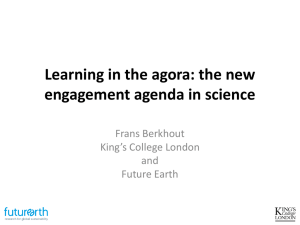

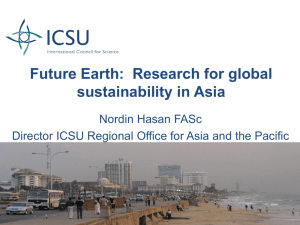
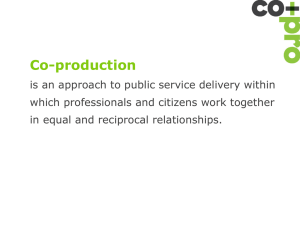
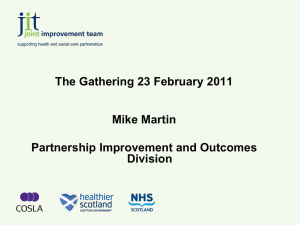
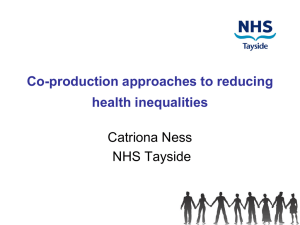
![Transformational Change [Powerpoint Presentation]](http://s2.studylib.net/store/data/005447411_1-da0a83bd34bdb90183940ab700125003-300x300.png)
